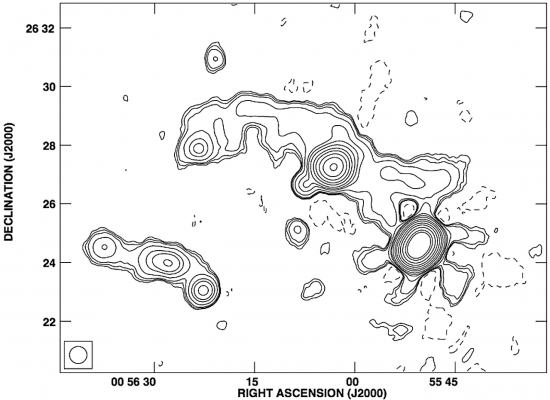
1.4 GHz VLA image of Abell 115, showing embedded bright radio galaxies. Credit: Govoni et al. 2001.
Jun 12, 2017
Hot gravity?
Astronomers have only one force in their bag of tricks: gravity. Anomalous observations, such as high temperature in galaxy clusters, “must be” caused by collisions. Shockwaves and ram pressure are invoked because it is assumed that celestial objects are pushing though a medium. It is friction from gravity-based interactions that heats them up. Electricity is sometimes mentioned in their reports, but the conclusion is always that its effect is negligible.
Plasma is said to be nothing more than ionized gas, behaving according to physical laws that apply to neutral gas. Since they cannot measure the properties of extragalactic space, directly, they develop mathematical models based on the behavior of neutral gases.
In a recent press release, that confirmation bias is present. Two galaxy clusters (Abell 115) are said to be “merging” forming a region of “…hot gas from turbulence caused by banging into each other at supersonic speeds.”
It should not be surprising that kinetic energy is the source of their theories about galaxies, in general. After all, particles streaming from stars are called a “wind” in the scientific press, instead of the flow of electric charge. Ionized particles accelerated by magnetic fields are referred to as “jets”, as if from a cosmic nozzle, instead of a collimated transmission of electricity through space. Changes in the density and speed of charged particles are “shock waves”, and not the mark of double layers that store and dissipate electricity. In the case of Abell 115, the 180 million Kelvin temperature is from an area that is like “a wake from a powerboat.”
A lack of knowledge about electricity in space can account for the opinion that gases “crashing into each other” produce X-rays and other energetic emissions. Since perception comes from training and education, without exposure to theories about the behavior of electricity flowing through plasma no perception of it can exist in the mind’s eye.
Among the many differences between plasma and models based on neutral gas are temperature anomalies like the ones seen in Abell 115: temperatures are 10 to 100 times higher than expected. From an Electric Universe point of view, anomalous readings are a normal property of plasma interaction between clusters. Saying that matter in the millions of Kelvin is nothing more than hot gas, or that X-rays are the result of colliding particles, betrays a lack of understanding about how plasmas in space work.
Nobel laureate Hannes Alfvén observed:
“We have to learn again that science without contact with experiments is an enterprise which is likely to go completely astray into imaginary conjecture.”
Stephen Smith












